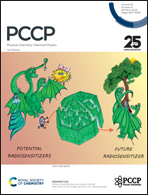Controllable electronic properties, contact barriers and contact types in a TaSe2/WSe2 metal–semiconductor heterostructure
Abstract
Two-dimensional (2D) metallic TaSe2 and semiconducting WSe2 materials have been successfully fabricated in experiments and are considered as promising contact and channel materials, respectively, for the design of next-generation electronic devices. Herein, we design a metal–semiconductor (M–S) heterostructure combining metallic TaSe2 and semiconducting WSe2 materials and investigate the atomic structure, electronic properties and controllable contact types of the combined TaSe2/WSe2 M–S heterostructure using first-principles calculations. Our results reveal that the TaSe2/WSe2 M–S heterostructure can adopt four different stable stacking configurations, all of which exhibit enhanced elastic constants compared to the constituent monolayers. Furthermore, the TaSe2/WSe2 M–S heterostructure exhibits p-type Schottky contact (SC) with Schottky barriers ranging from 0.36 to 0.49 eV, depending on the stacking configurations. The TaSe2/WSe2 M–S heterostructure can be considered as a promising M–S contact for next-generation electronic Schottky devices owing to its small tunneling resistivity of about 2.14 × 10−9 Ω cm2. More interestingly, the TaSe2/WSe2 M–S heterostructure exhibits tunable contact types and contact barriers under the application of an electric field. A negative electric field induces a transition from Schottky contact type to ohmic contact (OC) type. On the other hand, a positive electric field leads to a transformation from p-type SC to n-type SC. Our findings provide valuable insights into the practical applications of the TaSe2/WSe2 M–S heterostructure towards next-generation electronic devices.



 Please wait while we load your content...
Please wait while we load your content...